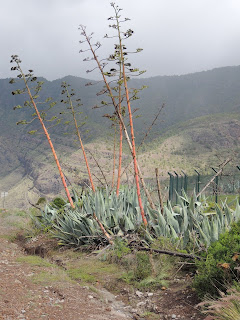Rumi
 |
| A map of Gran Canaria. We are starting all our hikes from 9 o'clock on the map: Aldea de San Nicolas. Haven't seen Santa yet! |
We walked over the landscape of volcanic rocks mostly interspersed with farms and plantations of bananas, mangoes, limes and squash, but also amongst yapping guard dogs (every small house has at least two) and through the village of Veneguera, where we enjoyed our lunch. While we cannot really claim to be walking in a garden, as Rumi suggests, we can claim to be seeing some interesting plant life.
 |
| Canarian wildflowers. |
 |
| Prickly pear cactus |
 |
| Our guide Bert calls these finger cactus and I guess you can see why! They are over 8 feet high. |
Also, we love our Smokies but it is difficult to get a vista except at the highest points or at the occasional pass. Here, the view is 360 nearly all the time and we can frequently see the ocean from the mountaintops.
 |
| Sky, ridge and palm trees |
 |
| Paul smiling because he is nearly to the end of the hike which started at a saddle in the mountain you see behind him. |
Today we passed around the village of Tasarte, through Veneguera and over the next pass to Mogan, which is a bit of a touristy town. This side of the island is not known for tourism, but Gran Canaria is trying to earn a reputation as an ecotourism hotspot for hiking. We certainly haven't been disappointed by their new direction.
This morning we started our walk in a rain and high wind in Tasartico in the mountains and ended in sunshine in the beach town of Mogan. Lots of diversity in weather, plants, landscapes and terrain.
Henry David Thoreau said a walk started in the morning is a blessing for the whole day. I wholeheartedly agree! Another walking bugger, John Muir, said that nature always gives us more than we seek and that's very true here on Gran Canaria. Very grateful for this opportunity to see a stunningly different part of this planet.
Paul's Ponderings: A great day out....three valleys and three summits. We had the full gamut of weather from rain to chill to sun to heat. We are the only folks from the USA here, mostly people from the UK and Canada, That said, it is a strong group of hikers and the day would put no one to shame from the view of being strenuous. Even though it was "only" about 10 miles, it was a full day out. Both the ascents and descents were tough at times but the view were well worth it. These are volcanic islands with serious peaks and associated scenery. We are always near ocean even if it is not obvious. Lots of arid plant life, including cactus, orange trees, bananas, papaya, palms, and more. This is Spain though, so the village life and food aligns with the mainland of Europe.
 |
| He's happiest on vacay! |
 |
| Our Dutch guide, Bert, points out the pine trees of the cloud forest. We haven't hiked there yet, but we are told we will in two days. |
Henry David Thoreau said a walk started in the morning is a blessing for the whole day. I wholeheartedly agree! Another walking bugger, John Muir, said that nature always gives us more than we seek and that's very true here on Gran Canaria. Very grateful for this opportunity to see a stunningly different part of this planet.
 |
| Chickens in a pen with cactus. Apparently PETA does not have a chapter here. |
Weirdly, wildlife here is pretty limited. We've seen one horse, no cows, and a lot of dogs, cats, and birds.
Why are these named the Canaries? The theory is twofold. One is the obvious one is that there are tropical birds. The other is there are lots of dogs, which in Latin translates to "cana" or "dog". No one really knows apparently.
Hiking-wise, so far so good. I've been using low hikers and a pack with water built in and it has worked so far. Some of the walk has been very loose rock, so it has been a bit challenging at times and I have sometimes wished I had higher boots for ankle protection....no disasters so far.
As mentioned before, Europe often uses these islands like US residents use the Caribbean islands...generally warm, scenic, and cheap. However, the interior and non-beach areas are totally unlike the Caribbean....huge peaks and valleys.
As many folks know, we like wine and this is a low production wine area, but quite unique. My take on these wines is they have an interesting heartiness to them, which has a bit less fruit and a bit more "vegetable" which is a unique quality. So far, I would not put them as world class, but pleasurable and intriguing and unlike anything you will taste from the normal wine growing areas in the US, Europe, or Australia. That alone makes them interesting, putting aside wine-hound comparisons.
This is a remote and unique area....it is a bit of a slog from the US, but worth it. Much more to come over the next several days!

No comments:
Post a Comment